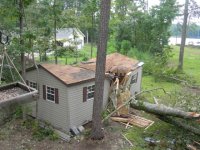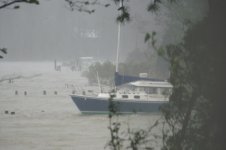On Isle of Palms, a barrier island adjacent to Sullivan's Island, the mayor and several police officers were sheltering in a 2-story building which lay at an elevation of ten feet. As related in a story published in the St. Petersburg Times, they heard the following bulletin on the radio at 10:30pm the night Hugo made landfall:
"The National Weather Service has issued a storm surge update. It appears that the storm surge will be greater than anticipated. It is now expected to reach a height of 17 to 21 feet."
"Mom didn't raise an idiot," said the one cop with the most sense, and he convinced the others to get off the island. They left the island by driving at 5 mph through horizontal sheets of rain and hurricane-force wind gusts over the Ben Sawyer Bridge, which connected Sullivan's Island to the mainland. As they crossed onto the bridge, they passed over a large bump--the bridge and road bed were at different levels. Not good. While crossing the bridge, they could feel it swaying and straining, and heard the sound of metal, twisting and grinding and breaking. They made it, but only barely--minutes later, the hurricane tore the center span of the bridge from its connection on both ends, leaving it a twisted ruin in the bay.
In McClellanville, on the coast thirty miles northeast of Charleston, between 500 - 1100 people took refuge at the designated shelter for the region, Lincoln High School. Lincoln High is a one-story school, mostly constructed of cinder block, located on the east side of Highway 17, and was believed to be at an altitude of twenty feet. McClellanville is about 4 - 5 miles inland from the open ocean, but lies on the Intracoastal Waterway, so is vulnerable to high storm surges. Near midnight on the 21st, a storm surge of twenty feet poured into Bulls Bay just south of McClellanville, and funneled into the narrow Intracoastal Waterway. Water started pouring into the high school and rose fairly rapidly. Within minutes, people were wading around up to their waists, the water still rising. In the school cafeteria, many refugees gathered on a stage at one end, putting children up on tables. The elevated stage kept them above water; others floated in the water. Another group was in the band room, which had a much lower ceiling than the cafeteria. They had to stand on desks and push out the ceiling tiles for more breathing room, as the water rose within 1 - 2 feet of the ceiling. Fortunately, Hugo's storm surge peaked at that time, at about 16 - 17 feet (Figure 4), and the people sheltering at Lincoln High were spared.
Figure 3.Estimated storm surge (height above ground) as estimated by NOAA's storm surge model, SLOSH. McClellanville (upper right) received a storm surge estimated at 16 - 17 feet.
According to Dr. Stephen Baig, the retired head of the NHC storm surge unit, the back-story is this: To build Lincoln High School, which lies at an altitude of ten feet, the local school board used the same plans that were drawn up for another school that is west of Highway 17, and that IS at 20 feet elevation. Not only the same plans, the same set of working drawings. Those working drawings showed a surveyed elevation of 20 feet above datum (probably NGVD29). Apparently Lincoln High was constructed either without benefit of elevation survey or the plans were not annotated with its site elevation. When the Red Cross inquired as to its utility as an evacuation site, whoever looked at the plans saw the surveyed elevation at 20 feet. That is what the Red Cross published. That is why the school was a designated shelter. Since that near-tragedy, the Red Cross requires a new elevation survey for every potential storm shelter. I think that at the time this was discovered all the designated shelters also were re-surveyed, just to be sure that no similar Lincoln High problems were waiting to happen.
4) Luck. The 20+ storm surge deaths on the Bolivar Peninsula in 2008 from Hurricane Ike show that there are still plenty of stubborn, unlucky, or uneducated people who will die when a significant storm surge hits a low-lying populated coast. The storm surge from the next major hurricane that sweeps through the Florida Keys is likely to cause a lot of storm surge deaths, since many residents there are pretty stubborn about not evacuating.


